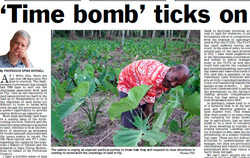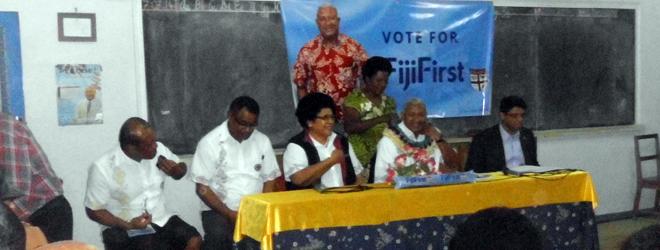| FijiFirst Party For Us: Lokia couple Petero Kaveni, 40, and his wife, Alisi Kaveni, 35, says on any given day, their government of choice would be one that "walks the talk". And out of all the political parties and governments they have lived under, FijiFirst embodies the idea, they said. "Their assistance is wholesome, benefits everyone and not just a group of people," Petero said. With five children, all of whom are girls, the couple's main concern is to ensure a better future and better Fiji for all them. And according to the couple, the free education provision to all primary and secondary school students, introduced by the government this year, is a move in the right direction, and an initiative they welcome with open arms. "We have three children who are attending school this year so the free education grant was a great help to us. We were able to focus what we could save on their stationery, their daily well-being and ensure they attend school daily with healthy lunches. "Every parent wants the best for their children and we are no different," Petero said. He said previous governments would talk the same talk, but when it came to delivering "it was a different matter." | |
They see what needs to be done and they do it. "He (Bainimarama) had come over to Lokia to watch one of the rugby matches featuring the Army team. He saw the state of the road and bridge and before we knew it, he sent back people from the army to work on it. So, if there is a party we will vote for, it'll be FijiFirst."
The Kaveni couple was among more than 350 people who attended the FijiFirst party's first campaign drive at Naikakogo Primary School last night. Source: Fijilive, 8 July 2014.
FROM THE ARCHIVES: Fijileaks will, from time to time, reproduce relevant and controversial opinion columns that were penned by VICTOR LAL in the Fiji Sun before the deportation of the then Fiji Sun publisher Russell Hunter in 2008. Lal's opinion pieces have been removed from Fiji Sun archives by the present pro-regime SUN team.
‘Where will you find in Fiji the Indian sitting under the tree
his father planted.’ - Governor Sir Arthur Richards
 Governor Richards
Governor Richards It was one of the wisest of Fiji’s colonial governors, Sir Arthur Richards (later Lord Milverton), who first offered to Ratu Sukuna the seed of an idea that produced the Native Land Trust Board. But it was Ratu Sukuna who planted the seed, nourished it, and gave the resulting plant sturdy growth and permanent form.
The preceding statement is how the NLTB has portrayed the great Lauan chief to us on its official website. In other words, if it had not been for Ratu Sukuna, the Fijians would have been a ‘people without a land’. Now, a row has broken out between Professor Ron Duncan of USP and NLTB general manager, Kalavati Bakani, on the role and function of the NLTB in Fijian society. Bakani’s robust response also smacks of ‘Hello, what do you know, Professor Duncan, about the NLTB and its role as a guardian of native lands in Fiji’.
What is the truth about NLTB and Ratu Sukuna? The answer will not be found in what has been written and perpetuated by the historians, the NLTB, the Fiji Government, and Fijian nationalists on Ratu Sukuna but what has not been written on the NLTB and the Lauan chief.
It lies in the examination of the private papers of Milverton, the initial architect of the NLTB, which has been gathering dust in the University of Oxford’s Rhodes House Library, the former depositary library of colonial studies. Milverton’s private and family papers are off limits to researchers. I was however recently granted permission to revaluate his private papers, especially those pertaining to his governorship in Fiji nearly 70 years ago.
Let us see how Ratu Sukuna came to be involved in the creation of the NLTB.
The NLTB was created in 1940 by the Native Land Trust Ordinance (also known as the NLTO). Governor Richards landed with his family in Suva on 28 November 1936. By early February 1937 he was confronted with a major ‘Indian problem’ which was visible on the horizon:
‘What are 200,000 people in a country which could easily support ten times that number? However at their present increase the future lies with the Indians. The Fijian is so far behind.’
He also remembered one grey-haired old Indian coming to him and saying: ‘Where will you find in Fiji the Indian sitting under the tree his father planted.’ He had an Indian cook, Bala.
On 26 February 1937, in a letter to Gerald Creasy of the British Colonial Office in London, he refers for the first time to Ratu Sukuna. At the time when Richards arrived in Suva, Ratu Sukuna was on a trip to Europe paid for by ‘voluntary’ contributions from the people. Richards proposed to ask him if this were true when he returned, but he had no intention of breaking him.
‘He is too potentially valuable and he would be a very dangerous malcontent. He is 49 years of age, a member of Leg Co and votes as he pleases. I have a mind to make him my Adviser on Native Affairs. I propose to gamble a little on him, to trust him and, I hope, to use him for the good of the country in solving the land question.’
His choice was a good one. They became friends with complete trust in each other and together they worked on Richards’ plan for land reform which would radically change the old communal system. The basis of the plan rested on the fact that the Fijian community possessed five times as much land as they could use either then or at any time in the future having regard to their visible population trends, and in pointing this out in speeches which he made to Fijian assemblies in every province throughout the country.
Richards made it plain that, if they insisted on holding back and they could not hope to use, which was their prerogative, the future of their country must be troubled. With diplomatic impartiality, he went on to point out what the Indians had done to bring prosperity to their country.
He wrote to Creasy on 7 September 1937: ‘People tell me that I have the confidence of the Fijians and anyway the name of the King’s representative is still something to conjure with here. The Fijians trust the King and will take from the Governor what they would take from no one else. Perhaps with Sukuna’s help I may be able to solve the problem. My idea is to turn him on to dividing up the country into lands surrendered by them to the Crown to be held in trust and allocated at the Crown’s will on what terms it considers just to anyone, Fijian or Indian or European, but the chief objective is the Indian. No more freehold - only long leases. I should constitute a small Board of which the Governor would be Chairman and would always sit as such, to deal with difficult decisions during the land division, and afterwards to be in general control of the allocations.’
All rent revenue from the land so allocated was to be paid into a welfare fund for the benefit of the indigenous Fijian population.
Ratu Sukuna supported the plan whole-heartedly and Richards warmly acknowledged the lead which he took in persuading the chiefs to agree to it. There were already young Fijians who were impatient with the old communal system and wanted personal freedom from it, but nevertheless the readiness of the chiefs and their people to agree to the proposals was probably the finest act of trust in colonial history.
Ratu Sukuna estimated that he could draw up the most equitable division of land within two or three years.
Unfortunately, Richards was transferred to Jamaica a few months later, and although the scheme was proceeded with for a time, it was hindered by the outbreak of the Second World War in 1939 before it could be implemented.
Professor Spike Boydell: Why Land is Central to Fiji's future stability?

http://customarylandsolutions.com/2014/06/07/why-land-is-central-to-fijis-future-stability/
and a related audio piece on ABC Radio Australia - Pacific Beat - http://www.radioaustralia.net.au/pacific/radio/program/pacific-beat/call-for-land-policies-ahead-of-fijis-elections/1332384?autoplay=1332412
Both are also available on Boydell's the Customary Land Solutions website: (www.customarylandsolutions.com).





